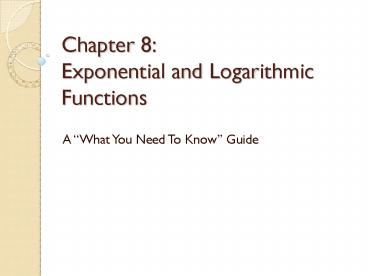Chapter 8: Exponential and Logarithmic Functions - PowerPoint PPT Presentation
1 / 20
Title:
Chapter 8: Exponential and Logarithmic Functions
Description:
Chapter 8: Exponential and Logarithmic Functions A What You Need To Know Guide Exponential Functions Basic equation: y = abx Growth functions Decay functions ... – PowerPoint PPT presentation
Number of Views:1010
Avg rating:3.0/5.0
Title: Chapter 8: Exponential and Logarithmic Functions
1
Chapter 8 Exponential and Logarithmic Functions
- A What You Need To Know Guide
2
Exponential Functions
- Basic equation y abx
- Growth functions
- Decay functions
- Half-life functions
- Interest problems
- Word problems
3
Growth Decay y abx
- r is rate of change, typically given as a
percent. (Must be changed to a decimal!) - Growth
- r rate of increase
- b 1 r
- Population increase, value appreciation, cell
reproduction, etc.
4
Growth Decay y abx
- Decay (0 lt b lt 1)
- r of decrease can be given as a negative
number - b 1 r
- Value depreciation, medication metabolization,
half-life - Half-Life
- Special type of decay question
- b 1 r where r is always 50, making b ½
- Decay of materials (Carbon-14, Technecium-99m,
etc)
5
Growth Decay General
- 1. Set-up y abx
- Total value (initial value)(growth/decay
factor)(time) - 2. Look (Graph)
6
Graphing Exponentials
- To graph
- Create an xy chart
- Use the values x -2, -1, 0, 1, 2 for x-values
- Evaluate to find corresponding y-values
- Graph the points on the coordinate grid
- Sketch the graph
- Growth functions y-values get bigger from -2 to
2 (go up from left to right) - Decay functions y-values get smaller from -2 to
2 (go down from left to right)
7
Growth Decay . . .
- are EXPONENTIAL FUNCTIONS (they contain
exponents). - Are evaluated using PEMDAS
- ARE NOT SOLVED USING LOGS! (they are evaluated!)
- are graphed using xy charts, plotting points,
and sketching the curve
8
Growth Decay Word Problems
Growth
Formula y a (1 r)x
Key Words Increase, Growth, Appreciate, etc.
Important Info The rate of change, b (or 1 r), is greater than 1. Answer should be larger than the initial value, a.
Number Placement End amount (initial amount)(rate of change)(time)
9
Growth Decay Word Problems
Decay
Formula y a (1 - r)x
Key Words Decrease, depreciate, decline, etc.
Important Info The rate of change, b (or 1 - r), has a value between 0 and 1, exclusively. Answer should be smaller than the initial value, a.
Number Placement End amount (initial amount)(rate of change)(time)
10
Growth Decay Word Problems
Half Life
Formula y a (1/2)x or y a(0.5)x Exponent is (time elapsed/length of half-life)
Key Words Half-life, decreases by half, etc.
Important Info The rate of change, b, always has a value of ½. Answer should be smaller than the initial value, a.
Number Placement End amount (initial amount)(1/2)(time elapsed/length of half-life)
11
Calculator Tips
- ALWAYS turn percents into decimals before using
them to evaluate ANYTHING! - ALWAYS follow the order of operations when
evaluating (PEMDAS) - Input only one operation at a time
- ALWAYS put the exponent for half-life in
(parenthesis)!!!
12
Logarithms
- Are the inverses of exponentials (they undo
exponentials). - Allow you to solve an equation with a variable in
the exponent. - Are graphed using the exponential version of the
equation - Follow VERY similar rules to exponents
13
Graphing Logarithms
- To graph
- Switch the logarithm into its exponential
counterpart. - Create an xy chart.
- Use the values x -2, -1, 0, 1, 2 for x-values.
- Evaluate to find corresponding y-values.
- To get the log graph, switch the x and y values.
- Graph the points and sketch the graph.
14
Logarithms as Inverses
- The logarithm function is the inverse of the
exponential function. - Definition of a logarithm (use this to change
forms) - logby x if y bx
- Iog10 called a common logarithm is the inverse
of a base 10 exponential function - LN or ln is called a natural logarithm and is
the inverse of a base e exponential function.
15
Evaluating a Logarithm
- For a base 10 logarithm, use the log button on
your calculator - For a base e logarithm, or a natural logarithm,
use the ln button on your calculator - For all other bases, use the change of base
formula - logbM log M
- log b
16
Properties of Logarithms
- VERY similar to exponential properties
- Used to combine like terms for logarithms (in
log equations) - Product Property
- logbM logbN logbMN
- Quotient Property
- logbM logbN logb(M/N)
- Power Property
- logbMx x logbM
17
Solving Exponential Equations
- Steps
- Isolate the exponential term (bx) using the
reverse order of operations. - Take the common logarithm on both sides (unless
its a base e, in that case you should use the
natural log LN) - Solve the remaining equation for the given
variable using the log properties and reverse
PEMDAS
18
Solving Exponential Equations
- Example
- Solve 4 5 72x-1
- Example using e
- Solve 4e2x1 5 12
19
Solving Logarithmic Equations
- Steps
- Use the log properties to combine like terms,
getting one logarithm, isolated. - Raise both sides to a power position, using the
base that matches the given logarithm (LN is base
e!!) to cancel the log. - Use reverse PEMDAS to solve for the given
variable.
20
Solving Logarithmic Equations
- Example
- Solve log(2x 1) 10
- Solve log2 log 3x 7
- Solve log3x-1 9
- Example using LN
- Solve LN3x 5 11
- 2LNx 2 15




























